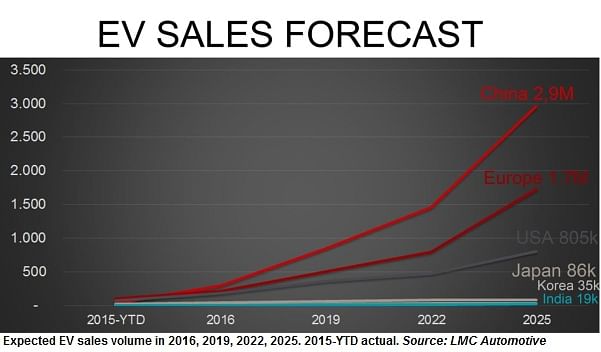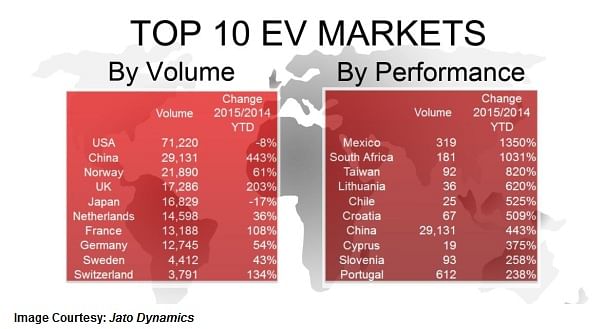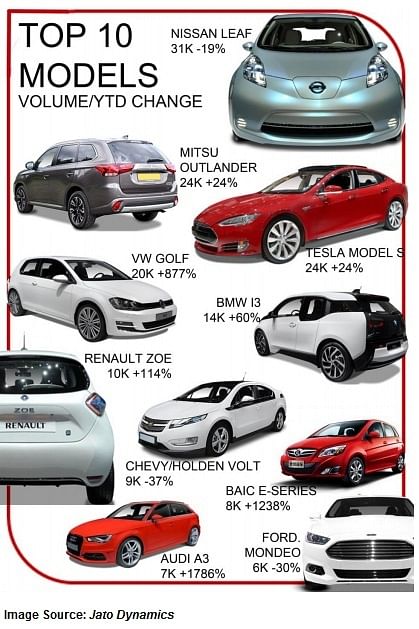5.5 million EVs to be on roads globally by 2025: Study
According to the study, Chinese market is expected to account for half of global sales while India will not contribute to even 1% of the total EV sales globally by 2025.
As the global automotive industry witnesses new breakthroughs in electric vehicle technologies and perception of consumers turns positive, EV sales are all set to rise significantly in the coming years and we could see as many as 5.5 million EVs on roads around the world by 2025, shows the latest study by automotive research firm Jato Dynamics.
Led by a surge in demand in China and some other European nations, EV sales are expected to cross the 700,000 units mark in 2016, from just 280,000 units in 2014. That is a massive 150% growth. Lots of factors have contributed in the rising popularity of electric vehicles globally. From initiatives by governments globally like subsidies and tax exemptions on EVs to manufacturers investing heavily in developing new technologies, all have aided the cause of EVs in the recent times.
According to the study, EV sales will continue to witness steady growth starting from next year and by 2022 the Chinese market is expected to account for half of global sales – almost 1.5 million units a year. India, however, will not contribute to even 1% of the total EV sales globally by 2025.

A Matter of Scale
Even as the numbers above seem impressive, they are still just a drop in the ocean when compared with total passenger car sales in the world.
In 2013, EVs accounted for 5.7% of Norway’s total passenger cars sales – the highest share seen anywhere in the world – thanks to the country’s generous incentive schemes. With the exception of the Netherlands, no other market achieved even a 1% share. A year later, the share in Norway jumped to 13.6%, and Estonia, Sweden and Latvia’s shares rose above 1%.

In the overall market scenario, the biggest challenge for EVs is to take market share from traditional segments and fuel types. Economic factors such as the fall in global oil prices will continue to have the greatest influence on purchasing decisions, to the detriment of EVs. Despite increasing awareness and a generally positive perception of EVs, many consumers are still waiting. Macroeconomic factors and infrastructure challenges play a large part, but there is also a lack of choice.
The total number of pure electric and plug-in hybrids cars available right now doesn’t exceed 70. That’s a low number compared to the huge variety of petrol cars on the market, but it should grow in the coming years as prices come down, more efficient batteries become available and tighter emissions regulations for the car industry take effect.
Top EV Models
Analysis of the best performing models shows that getting the electric car right as a manufacturer is the key to the company’s market standing. As such, the leading EV brand in Nissan makes the world’s leading EV model – the Leaf. This model alone is responsible for 97% of Nissan’s EV sales. A similar trend can be seen with Mitsubishi’s Outlander (95%) and Volkswagen’s electric Golf (90%).
Along with Tesla’s Model S, these four cars are at the top of the global sales table, followed by the BMW i3, Renault ZOE, Chevrolet Volt, Baic E-Series, Audi A3 and Ford Fusion. The BAIC E-Series/Senova enters the top ten after becoming the best-selling Chinese electric vehicle. By the end of August 2015, this compact MPV controlled more than 25% of the Chinese EV market, outselling 2014’s top-seller, the Zotye Zhidou E20, in the process. Another city car, the Zotye YUN100, sits in second place.

Long way ahead
Though growing at a rapid rate, electric vehicles are still a niche rather than a mainstream product. Numerous challenges stand in the way of a flourishing EV market. Many of these are the result of macroeconomic conditions which not only have a profound effect on purchasing habits but also on the ability of governments to offer financial incentives and support investment in the necessary infrastructure.
Nevertheless, there’s a growing consensus around the benefits of EVs. They can contribute to the reduction of CO2 emissions and can make us less dependent on oil. The environmental case has helped the industry to introduce EVs to consumers and give them a foothold in the market. The next step is to make electric cars a mass-market proposition.
According to the study, the industry, consumers and governments must all play an important role if this goal is to be achieved. Manufacturers must continue to work to develop the technologies that will make the next generation of EVs even more attractive to consumers both in terms of price and capability. Governments and regulators must help to create the conditions that allow EVs to better compete with conventional fuel cars.
RELATED ARTICLES
Volvo Cars signs recycled steel supply pact with SSAB
The recycled steel will be used in selected components of the forthcoming, fully electric EX60 SUV, as well as other car...
Schaeffler and NVIDIA ink technology collaboration to advance digital manufacturing
Using NVIDIA Omniverse, Schaeffler is expanding its production elements, which will be integrated and simulated as digit...
BMW Group to industrialise Virtual Factory, slash production planning costs
What once required several weeks of real-world modifications and testing can now be precisely simulated in the BMW Group...





 By Shourya Harwani
By Shourya Harwani
 18 Nov 2015
18 Nov 2015
 6722 Views
6722 Views





 Autocar Professional Bureau
Autocar Professional Bureau




